| Author |
Message |
Daniel Parry

|
 Posted: Sat 01 May, 2021 12:46 pm Post subject: Posted: Sat 01 May, 2021 12:46 pm Post subject: |
 |
|
Itís funny you should mention moving things on as my wife for the first time looked around my study/den and the top attic where I stash stuff not on display and suggested maybe I should consider selling a few things which I am now. She also queried whether I needed 6 pairs of cased duelling pistols in my collection at which point I just guided her out of the room. Obviously there are more than 6 pistol makers in the 18th and 19th century !
Although to be fair to her I could sell all of them and buy a really nice pair of mint Manton cased duelling pistols. Now thereís an idea.
|
|
  |
 |
Daniel Parry

|
 Posted: Sat 01 May, 2021 1:01 pm Post subject: Posted: Sat 01 May, 2021 1:01 pm Post subject: |
 |
|
That would be type 1 by my thinking. Nice sword and striking guard and large pommel.
One of the rapiers I have got recently may be French. But itís a funny thing that there are clearly identifiable English types, Italian types, Spanish types, Flemish/Dutch types and German types but the French rapier is elusive in that you see few which are confidently attributed as French in books and collections and they donít have a clear style to my mind but interested to hear othersí views. This one is quite close to an English dish hilt but with sone differences in form and feel that made me think maybe French.
|
|
  |
 |
|
Sean Manning
|
 Posted: Sat 01 May, 2021 7:09 pm Post subject: Posted: Sat 01 May, 2021 7:09 pm Post subject: |
 |
|
Would Oakeshott Collection OC012, a Spanish rapier with a blade made in 1596, count as a Parry type 2? https://sketchfab.com/3d-models/spanish-rapier-df2c9fa2668a4d6d9fde21485dc194b6
It looks like the blade is the longest allowed by Spanish law (give or take a few cm)
Edit: also, the base of the sharp part of the Spanish blade is only 5.6 mm thick versus 8-10 mm on the blades Fortner and Schrattenecker measured. It might be that some of these blade types are better for milling out of homogeneous steel than others.
weekly writing ~ material culture
|
|
  |
 |
Daniel Parry

|
 Posted: Sun 02 May, 2021 11:22 am Post subject: Posted: Sun 02 May, 2021 11:22 am Post subject: |
 |
|
Hi Sean
Firstly what an amazing tool that is. The ability to rotate the blade and see all angles - the only thing I cant work out is how to see the point in detail. But the way you can see the relative thickness and contours of the blade at different points, which is so key to their development is fantastic. Next best thing to handling them and a great resource for enthusiasts.
I think it would be a Type 2 by my way of looking at the world but slightly borderline as the fuller seems from the picture slightly shallower and the thickening of the forte to the ricasso less pronounced but yes I think I would say it was. All categories and imperfect and there are gradations between each particularly as all rapiers were hand made individually and no two are the same.
What I was trying to express with the type 2 was the lengthening of blades and the fuller becoming deeper and probably more functional in lightening the blade but providing strength but not too much stiffness And combined with the thick ricasso and thick blade cross section in the last third towards the hilt creates a blade which is not too whippy or rather is possibly whippy from the mid point of the blade. The Type ones if you wobble the blade from side to side have a consistent flex and wobble throughout the blade and if long blades can sometimes even dip a bit if you hold the sword out straight and feel a bit unstable. That depends on length and thickness and profile - hexagonal throughout are less bendy from what I have experienced than ones which become lenticular.
Also the ones which I would say are my type 2 often have narrower and thicker points and last few inches of the blade. The ones which fall in type one often have blades which are wider towards the point and get very thin in cross section - more like a general cut and thrust sword maybe than the type 2 which feels designed to deliver stiffer point thrusts. I also feel part of the balance of the type 1 is achieved by the gradually thinner cross section of the blade towards the point whereas with type 2 it achieved by greater thickness towards the point but narrowing the blade and thickening it towards the hilt. So the balance - I was comparing 2 rapiers of similar length just now - seems similar but the flex is different and the stiff density almost of the of the type 2 is different. They feel like they want to do slightly different things. .
And the ones which I see as type 2 sometimes start to lose the keen cutting edge at least for the first third to half of the blade which may in part be due to the thickening of the cross section in the third/half of the blade towards the hilt, whereas the type 1 swords appear mostly to have had a keen cutting edge throughout. That of course is subject the condition of the sword as blunting of sections could occur through cleaning as a collection piece.
It's difficult isnt it to categorise things as the more variants you see the more sub-categories you create. I guess what I am trying to say with my types is to identify the major changes I see in function and characteristics through the development of the rapier.
I am actually interested to see my measurements when I am done and spend more time looking at studies elsewhere as I think that seeing it in cold hard numbers may make me see better what it is I find hard to explain sometimes.
One of the reasons for my typology was not just because of visible differences or dimensions or periods but where you pick up the rapier and think this feels different - this feels like it's meant to do something different - there has been a change or development here.
|
|
  |
 |
|
Sean Manning
|
 Posted: Sun 02 May, 2021 5:25 pm Post subject: Posted: Sun 02 May, 2021 5:25 pm Post subject: |
 |
|
Hi Daniel,
I have not handled many original swords, but I think the way different people are trying to find ways to talk about how swords move and feel in the hand is really exciting. And just putting out information on more original rapiers would be helpful for people buying replicas and rapier foils.
Oakeshott's typology can't give every sword exactly one clear category either, but it lets people talk about similar swords without just pointing.
Sean
weekly writing ~ material culture
|
|
  |
 |
Daniel Parry

|
 Posted: Mon 03 May, 2021 11:38 am Post subject: Posted: Mon 03 May, 2021 11:38 am Post subject: |
 |
|
Sean
I couldn't agree more. A typology is a framework to think within which to think about how swords developed and it's the debates around categories and the gaps between that makes enthusiasts think further and perhaps realise things they hadn't before.
And I think we are becoming more attuned now to thinking about handling and dynamics and why forms changed. Or perhaps we are regaining it. There were some 19th century arms and armour authors who did talk a bit more about handling style, unfortunately many I think may have been too influenced by their own generation and viewed some older swords which didn't fit their concept of fencing as impractical or clumsy. Which is clearly wrong - you don't choose a weapon as a skilled swordsman to protect your life which is primitive or clumsy. That is a misunderstanding of the circumstances or method of combat of their time and environment.
I grew up with so many sword books (particularly on rapiers) which just said swept hilt, x date, maybe had the length and maybe had the weight (not often) but didn't talk about why there were differences much or at all. Norman is an incredible resource for the study of the subject but he focuses mostly on hilt styles and referencing those to portraiture and other identifiable time references. Don't get me wrong, Norman was one of those invaluable people who dedicated a huge amount of their life to researching and developing something which was a landmark in the subject. As are people more recently like Kinman on sword maker's marks - every rapier collector I know has his book as he covers the rapier period in the most detail I think.
I have friends who used to do a lot of fencing but are not historical collectors who come round our house and handle my rapier collection and comment things like: this one is as light as a fencing epee - I could fence with this; this one is like a fencing ;epee but the length is incredible - why so long; but this one is so much heavier; this one is more flexible and really sharp but that one isn't so sharp - why - it looks similar; this one is more blade heavy; why do these have these deep grooves and are more rigid but these have diamond shaped blades and are more whippy and sharper.
It's all those questions I am trying to sort in my head into something approaching a more function based analysis. Unfortunately I need to kick myself to do it. You actually have to set time aside and stick to it. The road to somewhere is based on good intentions !.
|
|
  |
 |
|
Sean Manning
|
 Posted: Tue 04 May, 2021 1:34 pm Post subject: Posted: Tue 04 May, 2021 1:34 pm Post subject: |
 |
|
Creating the Norman typology of hilts was definitely enough work for one book! Especially before ubiquitous computers and digital cameras. I am glad there is a reprint.
I think the idea of dynamics might get us into "what separates a rapier from other long straight complex-hilted swords." People come up with terms like "sidesword" or "military rapier" to describe the weapons which feel more "robust," or even try to create separate "rapier tournaments" and "sidesword tournaments." But realistically someone who used arms in the 16th and 17th century needed to be useful with a wide range of swords from long pokey swords to shorter cut-and-thrust swords. Someone who trained a point-oriented style like Nicoletto Giganti's might face someone with more of a cut-and-thrust style like Dall'Agocchie, and they both had to be able to use their training and their sword to defend themselves and offend the opponent.
Is Met 14.25.1169 a back rapier or a backsword? Its blade is about 1.36" or 35 mm wide at the cross. People outside England were not so interested in dividing straight swords into two classes as we are.
I would have called it a "sword" but someone at the Met says "rapier" and their Arms and Armour staff know their stuff.
weekly writing ~ material culture
|
|
  |
 |
Daniel Parry

|
 Posted: Wed 12 May, 2021 1:07 pm Post subject: Posted: Wed 12 May, 2021 1:07 pm Post subject: |
 |
|
Yes, that is what I have been saying in this thread and we are speaking from the same pulpit as it were. I often think if you had a time machine and presented these swords to people of the time would they have said 'rapier' vs 'military rapier' or just said' sword ... but I'd use that one in a duel and that one in a skirmish' That's exactly where I am getting to.
I often think the cavalier dish hilts in England (again mentioned in this thread) are perhaps the most interesting in that sense. You have ones which are long and heavy, ones which are long and narrow and light, and ones which are shorter are stiffer but all with very similar hits. And sometimes they are described as 'a shorter cavalier hilt rapier' or 'a longer cavalier hilt rapier' etc. But actually was it just a hilt style.
The time , the time .... and the dedication. On the job. Measurement results by end of the month.
D
|
|
  |
 |
|
Sean Manning
|
 Posted: Sat 21 Aug, 2021 7:14 pm Post subject: Posted: Sat 21 Aug, 2021 7:14 pm Post subject: |
 |
|
How is this project coming along Daniel? A minimal set of measurements that you actually make and publish is better than an exhaustive set of measurements that you give up on half way through.
weekly writing ~ material culture
|
|
  |
 |
Paul Hansen

|
 Posted: Sun 22 Aug, 2021 8:04 am Post subject: Posted: Sun 22 Aug, 2021 8:04 am Post subject: |
 |
|
The controls work as follows:
- Left mouse button: rotate
- Right mouse button: pan (move along one axis)
- Scroll wheel: zoom
Other swords and rapiers:
oakeshott" target="_blank">https://sketchfab.com/oakeshott
|
|
  |
 |
|
Sean Manning
|
 Posted: Tue 01 Feb, 2022 7:18 am Post subject: Posted: Tue 01 Feb, 2022 7:18 am Post subject: |
 |
|
Any news on this project Daniel? The reason I suggested a small set of measurements of each sword is that basic measurements for 10 swords which you make and share are much more useful than very detailed measurements which you get bored with and never finish. Don't let the perfect be the enemy of the good!
weekly writing ~ material culture
|
|
  |
 |
|
Sean Manning
|
 Posted: Tue 01 Feb, 2022 10:02 am Post subject: Posted: Tue 01 Feb, 2022 10:02 am Post subject: |
 |
|
Also, I have been looking into the hafts of staff weapons. It should not surprise myArmoury members that they very often change in cross-section from tip to butt too. Long spears such as the pikes in the Luzern Zeughaus or spears with ferrules from Iron Age Europe tend to be thickest at the butt or near where the front hand is placed. Spears from Britain 400-700 CE are usually thicker at the socket than the ferrule: perhaps they were good for throwing. John Waldman's 15th/16th century Swiss and German halberds tended to be thickest in the middle and lose about 3 mm of thickness at the ends. As we examine more original staff weapons, and play around with different types of staves, I think the advantages of different choices will become clear.
weekly writing ~ material culture
|
|
  |
 |
Daniel Parry

|
 Posted: Sun 05 Jun, 2022 1:42 pm Post subject: Getting there on the project with some help Posted: Sun 05 Jun, 2022 1:42 pm Post subject: Getting there on the project with some help |
 |
|
An interesting c1630 English rapier with detailed silver inlay work. Medium weight. Blade 42 inches and high quality.
 Attachment: 88.65 KB Attachment: 88.65 KB
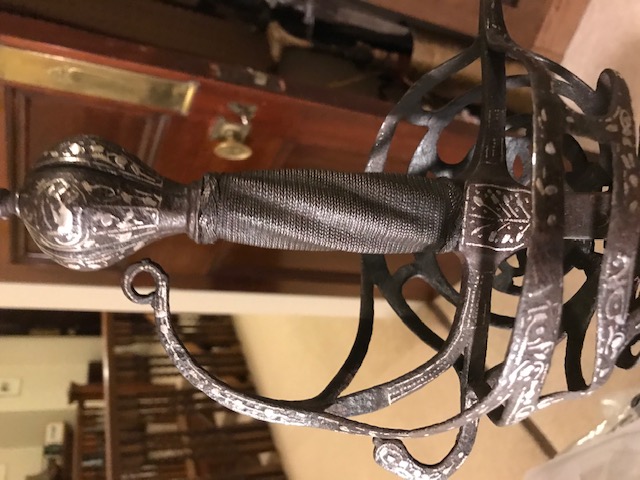
 Attachment: 67.54 KB Attachment: 67.54 KB
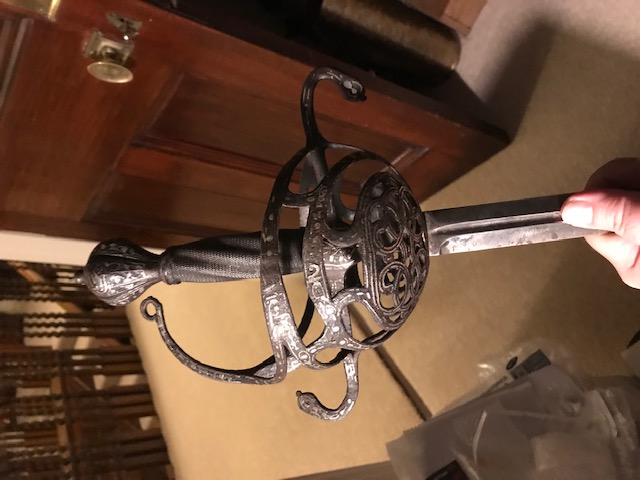
|
|
  |
 |
Daniel Parry

|
 Posted: Sun 05 Jun, 2022 1:53 pm Post subject: Posted: Sun 05 Jun, 2022 1:53 pm Post subject: |
 |
|
Unusually long probably Italian (certain traits look English but the massively wide dish and short quillons and decorative style make me thing maybe not.) duelling rapier, early to mid 17th century. Dish is huge but very finely executed with spiral ridges, interspersed with fine curved lines of dots.
Pommel very fine.
Blade of excellent temper and 51 inches long from the top of the guard. I thought this would be the longest rapier I could post here were it not for the one I acquired next.
 Attachment: 117.42 KB Attachment: 117.42 KB
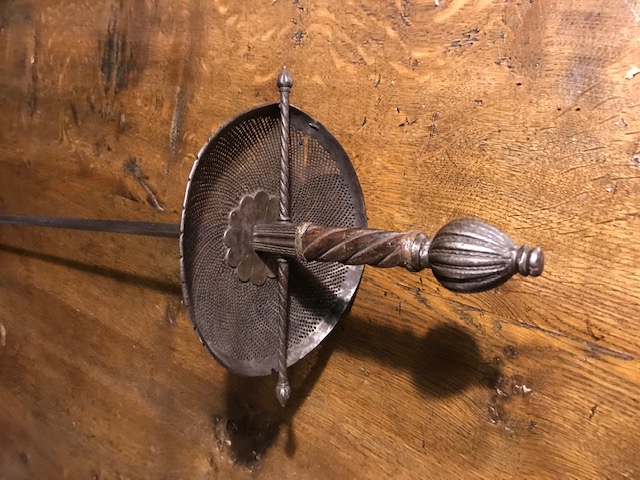
 Attachment: 108.08 KB Attachment: 108.08 KB
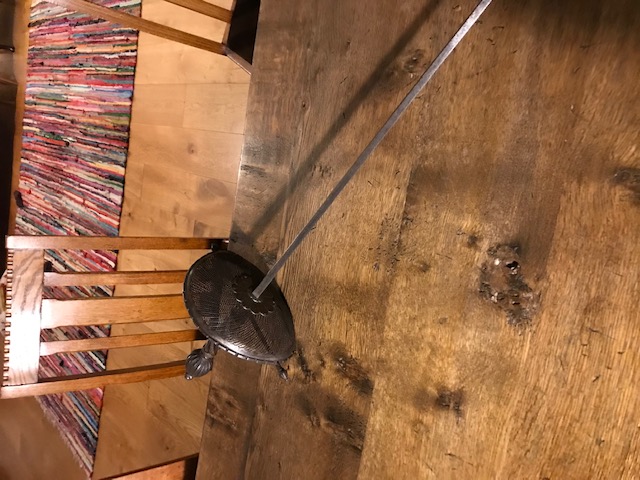
 Attachment: 92.46 KB Attachment: 92.46 KB
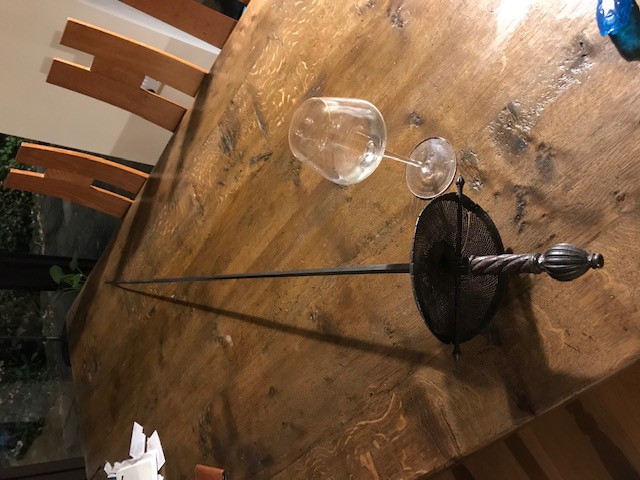
|
|
  |
 |
Daniel Parry

|
 Posted: Sun 05 Jun, 2022 2:10 pm Post subject: Posted: Sun 05 Jun, 2022 2:10 pm Post subject: |
 |
|
A good shorter military rapier, sometimes described as a Musketeer rapier. I have the example illustrated in the the 'Price Guide' and this is a a close cousin in terms of length and overall weight except this one has much finer hilt decoration and a finely pierced blade. It is also one of the early examples of the Colichemarde type blade as the forte is wide and strong hexagonal section but the blade then narrows to a thick but narrow hexagonal section blade with a clear step change at the forte. Interesting sword. It still has the leather wrap around the grip wire intact which is unusual.
 Attachment: 57.11 KB Attachment: 57.11 KB
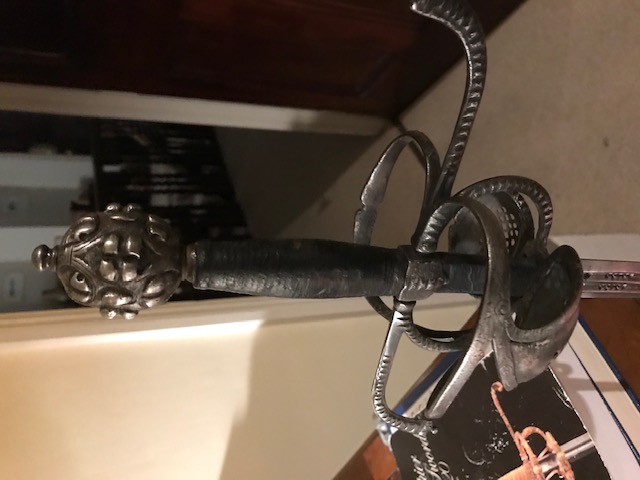
 Attachment: 55.61 KB Attachment: 55.61 KB
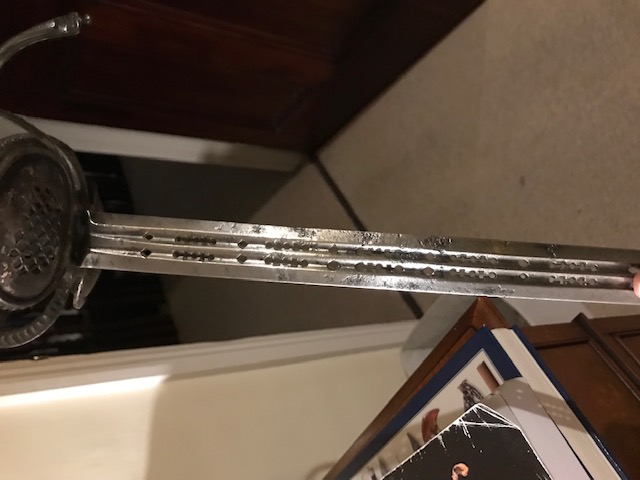
 Attachment: 57.56 KB Attachment: 57.56 KB
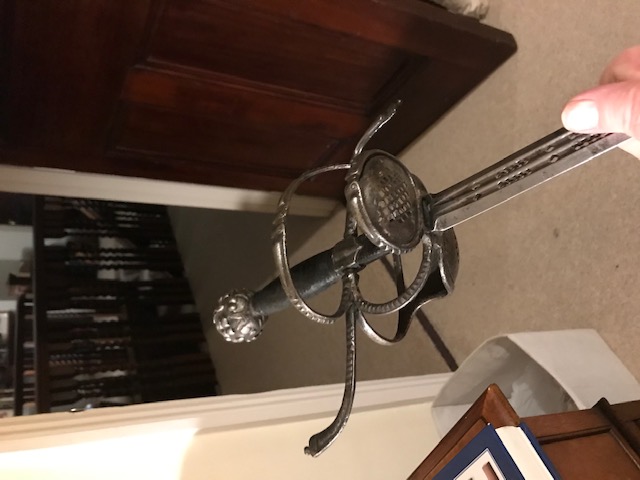
|
|
  |
 |
Daniel Parry

|
 Posted: Sun 05 Jun, 2022 2:27 pm Post subject: Posted: Sun 05 Jun, 2022 2:27 pm Post subject: |
 |
|
A very fine mesh guard dish hilt c 1650-1670. I suspect French. It's always difficult to identify French rapiers. The blade is short at 34 inches. It has a clearly razor sharp edge throughout and enough stiffness in the forte to be a good thrusting blade. Similar in handling to the better (i.e. not insanely long and floppy- bladed) transitional rapiers. As light as an early smallsword. Weight has clearly been minimalized in the design through the thin mesh guard and light weight quillons, pas d'ane and knucklebow.
 Attachment: 64.14 KB Attachment: 64.14 KB
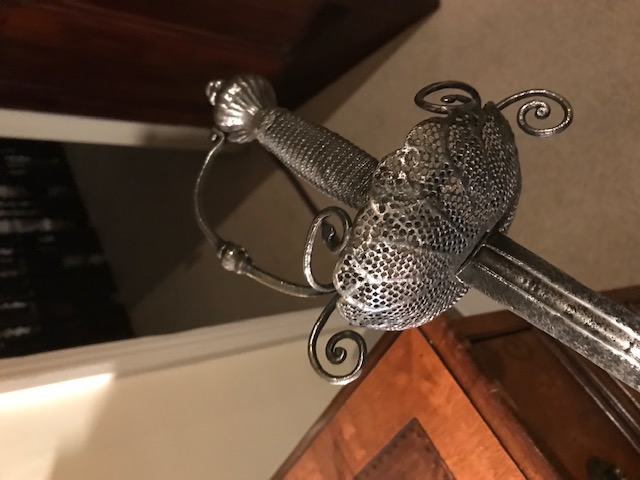
 Attachment: 51 KB Attachment: 51 KB
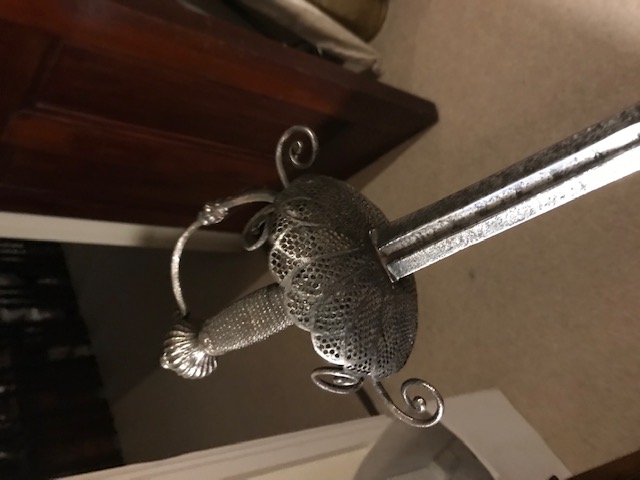
|
|
  |
 |
Daniel Parry

|
 Posted: Sun 05 Jun, 2022 2:49 pm Post subject: Posted: Sun 05 Jun, 2022 2:49 pm Post subject: |
 |
|
Interesting matched pair, first half of 17th century I think and possibly Flemish, though not sure. Sword is a well balanced cut and thrust sword, more akin to a lot of 16th century rapier/swords than 17th century. Dagger is a very well balanced 11 inch blade. Corrosion level is different to some degree between the dagger blade and the sword blade but don't see any obvious evidence of replacement or alteration.
 Attachment: 52.96 KB Attachment: 52.96 KB
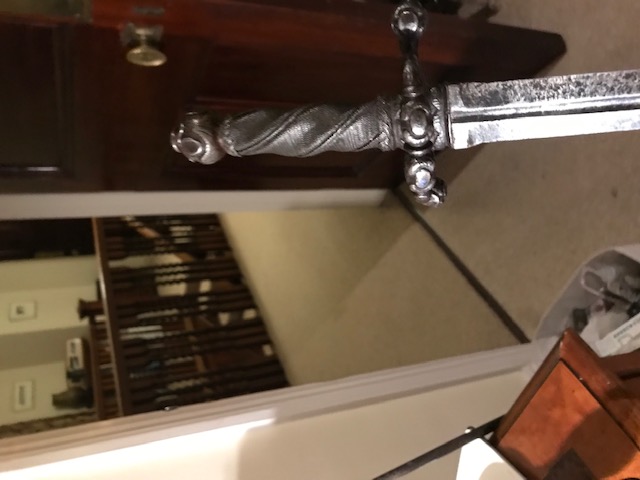
 Attachment: 60.12 KB Attachment: 60.12 KB
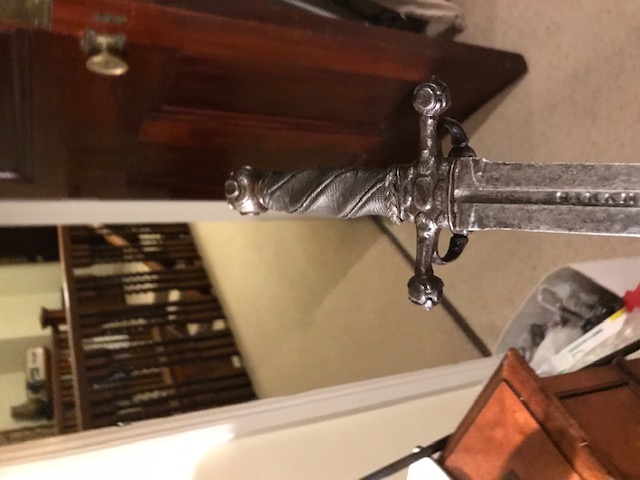
 Attachment: 63.1 KB Attachment: 63.1 KB
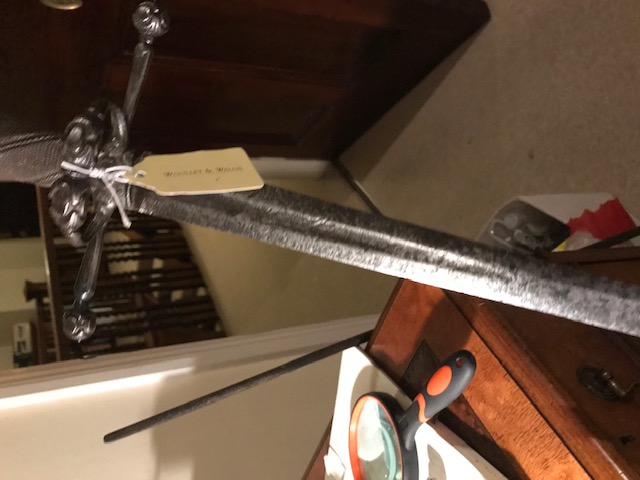
 Attachment: 61.56 KB Attachment: 61.56 KB
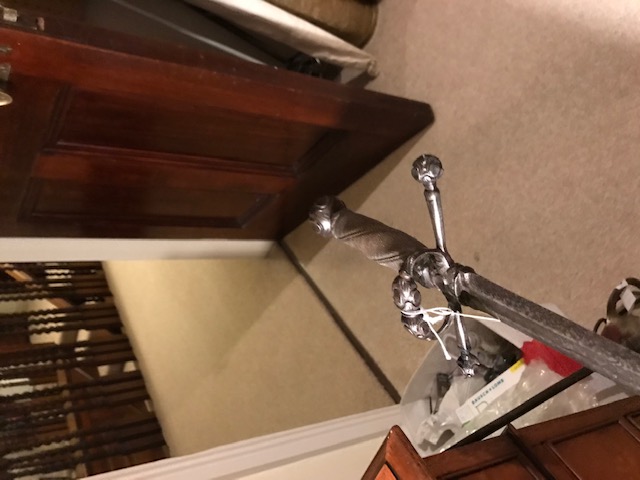
|
|
  |
 |
|
Sean Manning
|
 Posted: Sat 21 Jan, 2023 11:01 am Post subject: Posted: Sat 21 Jan, 2023 11:01 am Post subject: |
 |
|
Hi Daniel, how are those measurements coming along? A small set for half a dozen weapons which you actually publish would be useful for many rapier fans.
Edit: the pair with a single side ring are a interesting reminder that not everyone wanted very thorough hand protection (we see the same in the 18th century where there are smallsword hilts and stirrup hilts). How wide are the blades at the cross? I wonder if Sir John Smythe would have called them an arming sword and dagger.
weekly writing ~ material culture
Last edited by Sean Manning on Sun 22 Jan, 2023 4:00 pm; edited 1 time in total
|
|
  |
 |
|
Martin Buckley
Location: Wales, U.K. Joined: 23 Jul 2006
Posts: 128
|
 Posted: Sun 22 Jan, 2023 6:54 am Post subject: Posted: Sun 22 Jan, 2023 6:54 am Post subject: |
 |
|
|
Iíve seen many of these rapiers on antique sites over the years. Itís great to see them close up and in a different light, it really gives them an extra something. Compliments to those whoíve purchased them, I, for one, am phenomenally jealous.
|
|
  |
 |
Daniel Parry

|
 Posted: Wed 25 Jan, 2023 5:51 am Post subject: Posted: Wed 25 Jan, 2023 5:51 am Post subject: |
 |
|
Hi Sean and Martin
The blades are an inch wide at the cross. The sword is a general use cut and thrust blade, nicely balanced. Hard to date these forms sometimes as similar crop up in the 16th and 17th centuries (and the lighter sword with cross and side ring was around in the 15th century). Different I think to some of the mid-16th century swords which are looked at as early rapiers, where if you squint at them and remove the side rings and the simple hilt bars in your mind's eye, they are basically estocs in a lot cases, with a less generalised blade profile.
As for the rapier measurements, I have finally got off my lazy arse over the Christmas period and am nearly finished. I have done 40 rapiers from c. 1580 to 1680 to show the change in style and form. I want to run the results past a couple of other collectors and enthusiasts I know to see if they see anomalies or things which need adding in. It took a while as the measurements need to be seen in the context of the style as well the date, as a duelling rapier from 1630 will not have the same physical characteristics as a Pappenheimer from 1630.
This also leads into different blade profiles being suitable for different rapiers according to use not just period.
So I am filling out comments areas as much as I can without it being too wordy as doing it on Excel. I will put them in date order but if I put 'cuphilt' or 'swept-hilt' in one column and 'duelling' or 'general' in another and country (by hilt style and blade-maker where I can as they are often different) in another, people can search and re-arrange.
You really need 200 or so for statistical results but it might be interesting for people and comparable with other results from elsewhere. I also need to extend my blade profile categories !
I am away in the US for work for a few weeks then when back I will do the last few and post it. It has purely been that getting started thing - laziness - once underway with all the measuring stuff out I got into it !
|
|
  |
 |
|
|

